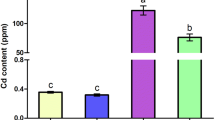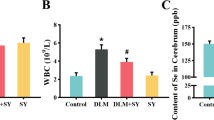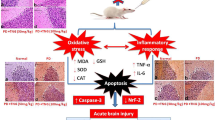Abstract
Arsenic (As) as a neurotoxic environmental pollutant has attracted extensive attention. Curcumin (Cur) is a natural antioxidant that shows an excellent protective effect against arsenic trioxide (ATO)–induced toxicity in many animal organs. However, the mechanism of Cur against ATO-induced hypothalamic toxicity in ducks has not yet been fully elucidated. Here, ducks were treated with ATO and/or Cur during 28 days; the results showed that ATO exposure induced growth retardation, messy feathers, and abnormal posture in ducks. Moreover, ATO caused neuron vacuolar degeneration and disintegration in the hypothalamus of ducks. Simultaneously, ATO induced blood–brain barrier damage, downregulated the expression of ZO-1, Occludin, and mediated NF‐κB activation, resulting in an increase in inflammatory factors (TLR-4, NF-κB, TNF-α, IL-2, and IL-6). Furthermore, ATO increased the production of pyroptosis-related factors (Caspase-1, IL-18, IL-1), exacerbating the inflammatory damage through NLRP3-mediated inflammasome activation. Cur, on the other hand, exerted excellent inhibitory effects on inflammation and pyroptosis. In summary, our study revealed that ATO triggered inflammation and pyroptosis by modulating NF-κB/NLRP3 signaling pathways in the hypothalamus of ducks, and Cur can alleviate inflammation and pyroptosis caused by ATO. Therefore, as a plant extract, Cur has the potential to prevent and cure ATO-induced hypothalamus toxicity.
Graphical Abstract






Similar content being viewed by others
Data Availability
The datasets used and/or analyzed during the current study are available from the corresponding author on reasonable request.
References
Jiang X, Yu W, Wu S, Tang L, Zhong G, Wan F, Lan J, Zhang H, Pan J, Tang Z, Zhang X, Hu L, Huang R (2021) Arsenic (III) and/or Antimony (III) induced disruption of calcium homeostasis and endoplasmic reticulum stress resulting in apoptosis in mice heart. Ecotoxicol Environ Saf 220:112394. https://doi.org/10.1016/j.ecoenv.2021.112394
Das HK, Mitra AK, Sengupta PK, Hossain A, Islam F, Rabbani GH (2004) Arsenic concentrations in rice, vegetables, and fish in Bangladesh: a preliminary study. Environ Int 30(3):383–387. https://doi.org/10.1016/j.envint.2003.09.005
Karri V, Schuhmacher M, Kumar V (2016) Heavy metals (Pb, Cd, As and MeHg) as risk factors for cognitive dysfunction: a general review of metal mixture mechanism in brain. Environ Toxicol Pharmacol 48:203–213. https://doi.org/10.1016/j.etap.2016.09.016
Shao YZ, Zhao HJ, Wang Y, Liu JJ, Li JL, Luo LY, Xing MW (2018) The apoptosis in arsenic-induced oxidative stress is associated with autophagy in the testis tissues of chicken. Poult Sci 97(9):3248–3257. https://doi.org/10.3382/ps/pey156
Moon KA, Oberoi S, Barchowsky A, Chen Y, Guallar E, Nachman KE, Rahman M, Sohel N, D’Ippoliti D, Wade TJ, James KA, Farzan SF, Karagas MR, Ahsan H, Navas-Acien A (2018) A dose-response meta-analysis of chronic arsenic exposure and incident cardiovascular disease. Int J Epidemiol 47(3):1013. https://doi.org/10.1093/ije/dyy073
Zhong G, Wan F, Lan J, Jiang X, Wu S, Pan J, Tang Z, Hu L (2021) Arsenic exposure induces intestinal barrier damage and consequent activation of gut-liver axis leading to inflammation and pyroptosis of liver in ducks. Sci Total Environ 788:147780. https://doi.org/10.1016/j.scitotenv.2021.147780
Sharma A, Kumar S (2019) Arsenic exposure with reference to neurological impairment: an overview. Rev Environ Health 34(4):403–414. https://doi.org/10.1515/reveh-2019-0052
Garza-Lombo C, Pappa A, Panayiotidis MI, Gonsebatt ME, Franco R (2019) Arsenic-induced neurotoxicity: a mechanistic appraisal. J Biol Inorg Chem 24(8):1305–1316. https://doi.org/10.1007/s00775-019-01740-8
Adlanmerini M, Nguyen HC, Krusen BM, Teng CW, Geisler CE, Peed LC, Carpenter BJ, Hayes MR, Lazar MA (2021) Hypothalamic REV-ERB nuclear receptors control diurnal food intake and leptin sensitivity in diet-induced obese mice. J Clin Invest 131(1) https://doi.org/10.1172/JCI140424
Cui T, Jiang W, Yang F, Luo J, Hu R, Cao H, Hu G, Zhang C (2021) Molybdenum and cadmium co-induce hypothalamus toxicity in ducks via disturbing Nrf2-mediated defense response and triggering mitophagy. Ecotoxicol Environ Saf 228:113022. https://doi.org/10.1016/j.ecoenv.2021.113022
Prakash C, Soni M, Kumar V (2016) Mitochondrial oxidative stress and dysfunction in arsenic neurotoxicity: a review. J Appl Toxicol 36(2):179–188. https://doi.org/10.1002/jat.3256
Yu S, Fu L, Lu J, Wang Z, Fu W (2020) Xiao-Yao-San reduces blood-brain barrier injury induced by chronic stress in vitro and vivo via glucocorticoid receptor-mediated upregulation of Occludin. J Ethnopharmacol 246:112165. https://doi.org/10.1016/j.jep.2019.112165
Daneman R, Prat A (2015) The blood-brain barrier. Cold Spring Harb Perspect Biol 7(1):a20412. https://doi.org/10.1101/cshperspect.a020412
Wu S, Rao G, Wang R, Pang Q, Zhang X, Huang R, Li T, Tang Z, Hu L (2021) The neuroprotective effect of curcumin against ATO triggered neurotoxicity through Nrf2 and NF-kappaB signaling pathway in the brain of ducks. Ecotoxicol Environ Saf 228:112965. https://doi.org/10.1016/j.ecoenv.2021.112965
Adedara IA, Abiola MA, Adegbosin AN, Odunewu AA, Farombi EO (2019) Impact of binary waterborne mixtures of nickel and zinc on hypothalamic-pituitary-testicular axis in rats. Chemosphere 237:124501. https://doi.org/10.1016/j.chemosphere.2019.124501
Wang C, Nie G, Yang F, Chen J, Zhuang Y, Dai X, Liao Z, Yang Z, Cao H, Xing C, Hu G, Zhang C (2020) Molybdenum and cadmium co-induce oxidative stress and apoptosis through mitochondria-mediated pathway in duck renal tubular epithelial cells. J Hazard Mater 383:121157. https://doi.org/10.1016/j.jhazmat.2019.121157
Wang X, Cao H, Fang Y, Bai H, Chen J, Xing C, Zhuang Y, Guo X, Hu G, Yang F (2022) Activation of endoplasmic reticulum-mitochondria coupling drives copper-induced autophagy in duck renal tubular epithelial cells. Ecotoxicol Environ Saf 235:113438. https://doi.org/10.1016/j.ecoenv.2022.113438
Moeini A, Torrecilla S, Tovar V, Montironi C, Andreu-Oller C, Peix J, Higuera M, Pfister D, Ramadori P, Pinyol R, Sole M, Heikenwalder M, Friedman SL, Sia D, Llovet JM (2019) An immune gene expression signature associated with development of human hepatocellular carcinoma identifies mice that respond to chemopreventive agents. Gastroenterology 157(5):1383–1397. https://doi.org/10.1053/j.gastro.2019.07.028
Baldwin AJ (1996) The NF-kappa B and I kappa B proteins: new discoveries and insights. Annu Rev Immunol 14:649–683. https://doi.org/10.1146/annurev.immunol.14.1.649
Kwon DJ, Bae YS, Ju SM, Youn GS, Choi SY, Park J (2014) Salicortin suppresses lipopolysaccharide-stimulated inflammatory responses via blockade of NF-kappaB and JNK activation in RAW 264.7 macrophages. Bmb Rep 47(6):318–323. https://doi.org/10.5483/bmbrep.2014.47.6.200
Deng M, Guo H, Tam JW, Johnson BM, Brickey WJ, New JS, Lenox A, Shi H, Golenbock DT, Koller BH, Mckinnon KP, Beutler B, Ting JP (2019) Platelet-activating factor (PAF) mediates NLRP3-NEK7 inflammasome induction independently of PAFR. J Exp Med 216(12):2838–2853. https://doi.org/10.1084/jem.20190111
Bertheloot D, Latz E, Franklin BS (2021) Necroptosis, pyroptosis and apoptosis: an intricate game of cell death. Cell Mol Immunol 18(5):1106–1121. https://doi.org/10.1038/s41423-020-00630-3
Gaul S, Leszczynska A, Alegre F, Kaufmann B, Johnson CD, Adams LA, Wree A, Damm G, Seehofer D, Calvente CJ, Povero D, Kisseleva T, Eguchi A, Mcgeough MD, Hoffman HM, Pelegrin P, Laufs U, Feldstein AE (2021) Hepatocyte pyroptosis and release of inflammasome particles induce stellate cell activation and liver fibrosis. J Hepatol 74(1):156–167. https://doi.org/10.1016/j.jhep.2020.07.041
Vallee A, Lecarpentier Y (2020) Curcumin and endometriosis. Int J Mol Sci 21(7). https://doi.org/10.3390/ijms21072440
Abdel-Daim MM, El-Tawil OS, Bungau SG, Atanasov AG (2019) Applications of antioxidants in metabolic disorders and degenerative diseases: mechanistic approach. Oxid Med Cell Longev 2019:4179676. https://doi.org/10.1155/2019/4179676
Salehi B, Stojanovic-Radic Z, Matejic J, Sharifi-Rad M, Anil KN, Martins N, Sharifi-Rad J (2019) The therapeutic potential of curcumin: a review of clinical trials. Eur J Med Chem 163:527–545. https://doi.org/10.1016/j.ejmech.2018.12.016
Bahrami A, Sathyapalan T, Moallem SA, Sahebkar A (2020) Counteracting arsenic toxicity: curcumin to the rescue? J Hazard Mater 400:123160. https://doi.org/10.1016/j.jhazmat.2020.123160
Lan J, Tang L, Wu S, Huang R, Zhong G, Jiang X, Tang Z, Hu L (2022) Curcumin alleviates arsenic-induced injury in duck skeletal muscle via regulating the PINK1/Parkin pathway and protecting mitochondrial function. Toxicol Appl Pharmacol 434:115820. https://doi.org/10.1016/j.taap.2021.115820
Wu S, Yu W, Jiang X, Huang R, Zhang X, Lan J, Zhong G, Wan F, Tang Z, Hu L (2021) Protective effects of curcumin on ATO-induced nephrotoxicity in ducks in relation to suppressed autophagy, apoptosis and dyslipidemia by regulating oxidative stress. Ecotoxicol Environ Saf 219:112350. https://doi.org/10.1016/j.ecoenv.2021.112350
Mochizuki H (2019) Arsenic neurotoxicity in humans. Int J Mol Sci 20(14). https://doi.org/10.3390/ijms20143418
Flora SJ (2011) Arsenic-induced oxidative stress and its reversibility. Free Radic Biol Med 51(2):257–281. https://doi.org/10.1016/j.freeradbiomed.2011.04.008
Li X, Yi H, Wang H (2018) Sulphur dioxide and arsenic affect male reproduction via interfering with spermatogenesis in mice. Ecotoxicol Environ Saf 165:164–173. https://doi.org/10.1016/j.ecoenv.2018.08.109
Piao Y, Liu Y, Xie X (2013) Change trends of organ weight background data in Sprague Dawley rats at different ages. J Toxicol Pathol 26(1):29–34. https://doi.org/10.1293/tox.26.29
Zhao Y, Zhuang Y, Shi Y, Xu Z, Zhou C, Guo L, Liu P, Wu C, Hu R, Hu G, Guo X, Xu L (2021) Effects of N-acetyl-l-cysteine on heat stress-induced oxidative stress and inflammation in the hypothalamus of hens. J Therm Biol 98:102927. https://doi.org/10.1016/j.jtherbio.2021.102927
Abbott NJ, Patabendige AA, Dolman DE, Yusof SR, Begley DJ (2010) Structure and function of the blood-brain barrier. Neurobiol Dis 37(1):13–25. https://doi.org/10.1016/j.nbd.2009.07.030
Bao L, Shi H (2010) Arsenite induces endothelial cell permeability increase through a reactive oxygen species-vascular endothelial growth factor pathway. Chem Res Toxicol 23(11):1726–1734. https://doi.org/10.1021/tx100191t
Pulido-Moran M, Moreno-Fernandez J, Ramirez-Tortosa C, Ramirez-Tortosa M (2016) Curcumin and health. Molecules 21(3):264. https://doi.org/10.3390/molecules21030264
Didonato JA, Mercurio F, Karin M (2012) NF-kappaB and the link between inflammation and cancer. Immunol Rev 246(1):379–400. https://doi.org/10.1111/j.1600-065X.2012.01099.x
Leitner GR, Wenzel TJ, Marshall N, Gates EJ, Klegeris A (2019) Targeting Toll-like receptor 4 to modulate neuroinflammation in central nervous system disorders. Expert Opin Ther Targets 23(10):865–882. https://doi.org/10.1080/14728222.2019.1676416
Opal SM, Depalo VA (2000) Anti-inflammatory cytokines. Chest 117(4):1162–1172. https://doi.org/10.1378/chest.117.4.1162
Zhang K, Zhao P, Guo G, Guo Y, Tian L, Sun X, Li S, He Y, Sun Y, Chai H, Zhang W, Xing M (2016) Arsenic trioxide attenuates NF-kappaB and cytokine mRNA levels in the livers of cocks. Biol Trace Elem Res 170(2):432–437. https://doi.org/10.1007/s12011-015-0455-8
Zhong W, Qian K, Xiong J, Ma K, Wang A, Zou Y (2016) Curcumin alleviates lipopolysaccharide induced sepsis and liver failure by suppression of oxidative stress-related inflammation via PI3K/AKT and NF-kappaB related signaling. Biomed Pharmacother 83:302–313. https://doi.org/10.1016/j.biopha.2016.06.036
Zhang J, Zheng Y, Luo Y, Du Y, Zhang X, Fu J (2019) Curcumin inhibits LPS-induced neuroinflammation by promoting microglial M2 polarization via TREM2/ TLR4/ NF-kappaB pathways in BV2 cells. Mol Immunol 116:29–37. https://doi.org/10.1016/j.molimm.2019.09.020
Chen S, Tang C, Ding H, Wang Z, Liu X, Chai Y, Jiang W, Han Y, Zeng H (2020) Maf1 ameliorates sepsis-associated encephalopathy by suppressing the NF-kB/NLRP3 inflammasome signaling pathway. Front Immunol 11:594071. https://doi.org/10.3389/fimmu.2020.594071
Chen X, Liu G, Yuan Y, Wu G, Wang S, Yuan L (2019) NEK7 interacts with NLRP3 to modulate the pyroptosis in inflammatory bowel disease via NF-kappaB signaling. Cell Death Dis 10(12):906. https://doi.org/10.1038/s41419-019-2157-1
Voet S, Srinivasan S, Lamkanfi M, van Loo G (2019) Inflammasomes in neuroinflammatory and neurodegenerative diseases. Embo Mol Med 11(6). https://doi.org/10.15252/emmm.201810248
Yu W, Qin X, Zhang Y, Qiu P, Wang L, Zha W, Ren J (2020) Curcumin suppresses doxorubicin-induced cardiomyocyte pyroptosis via a PI3K/Akt/mTOR-dependent manner. Cardiovasc Diagn Ther 10(4):752–769. https://doi.org/10.21037/cdt-19-707
Palma-Lara I, Martinez-Castillo M, Quintana-Perez JC, Arellano-Mendoza MG, Tamay-Cach F, Valenzuela-Limon OL, Garcia-Montalvo EA, Hernandez-Zavala A (2020) Arsenic exposure: a public health problem leading to several cancers. Regul Toxicol Pharmacol 110:104539. https://doi.org/10.1016/j.yrtph.2019.104539
Xiao J, Jiang X, Zhou Y, Sumayyah G, Zhou L, Tu B, Qin Q, Qiu J, Qin X, Zou Z, Chen C (2022) Results of a 30-day safety assessment in young mice orally exposed to polystyrene nanoparticles. Environ Pollut 292(Pt B):118184. https://doi.org/10.1016/j.envpol.2021.118184
Author information
Authors and Affiliations
Contributions
Conceptualization: Rao Gan, Haiyan Liu; methodology: Gan Rao, Shaofeng Wu; formal analysis and investigation: Gan Rao, Ning Zhang, Riming Huang; writing—original draft preparation: Lianmei Hu; writing—review and editing: Lianmei Hu, Riming Huang; funding acquisition: Zhaoxin Tang, Lianmei Hu; resources: Lianmei Hu; supervision: Lianmei Hu.
Corresponding authors
Ethics declarations
Author Agreement
We the undersigned declare that this manuscript is original, has not been published before and is not currently being considered for publication elsewhere.
We confirm that the manuscript has been read and approved by all named authors and that there are no other persons who satisfied the criteria for authorship but are not listed.
We further confirm that the order of authors listed in the manuscript has been approved by all of us. We understand that the Corresponding Author is the sole contact for the Editorial process. He/she is responsible for communicating with the other authors about progress, submissions of revisions and final approval of proofs.
Signed by all the authors.
Conflict of Interest
The authors declare no competing interests.
Additional information
Publisher's Note
Springer Nature remains neutral with regard to jurisdictional claims in published maps and institutional affiliations.
Highlights
• Oral intake of ATO-triggered hypothalamic toxicity in ducks.
• ATO cross BBB and lead to inflammation and pyroptosis in hypothalamic of ducks.
• Cur alleviated ATOinduced poising in hypothalamic of ducks.
Supplementary Information
Below is the link to the electronic supplementary material.
Rights and permissions
About this article
Cite this article
Gan, R., Liu, H., Wu, S. et al. Curcumin Alleviates Arsenic Trioxide–Induced Inflammation and Pyroptosis via the NF-κB/NLRP3 Signaling Pathway in the Hypothalamus of Ducks. Biol Trace Elem Res 201, 2503–2511 (2023). https://doi.org/10.1007/s12011-022-03321-4
Received:
Accepted:
Published:
Issue Date:
DOI: https://doi.org/10.1007/s12011-022-03321-4




